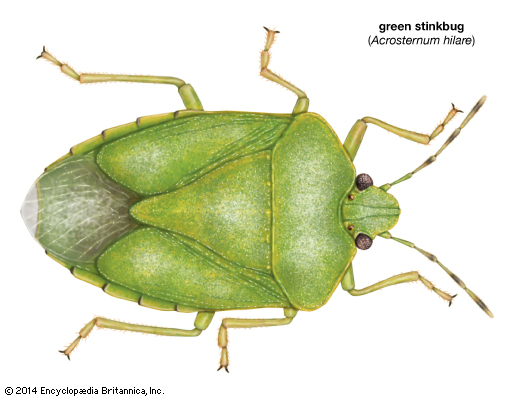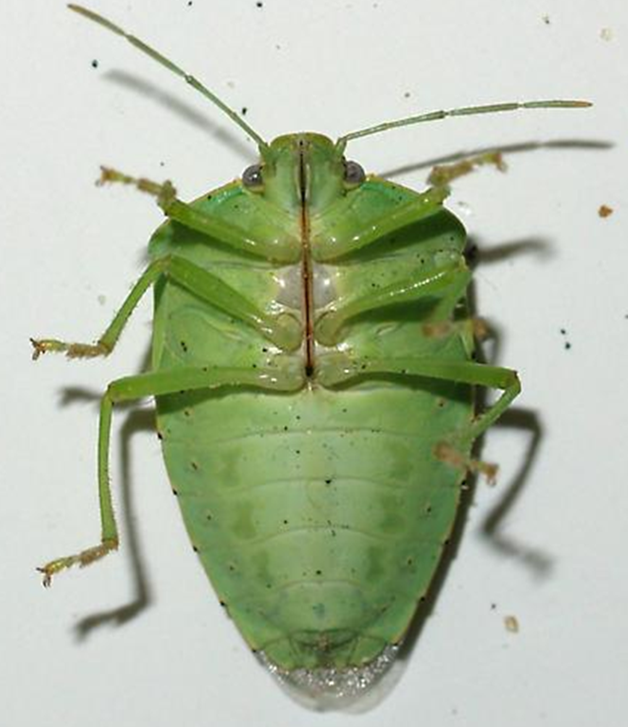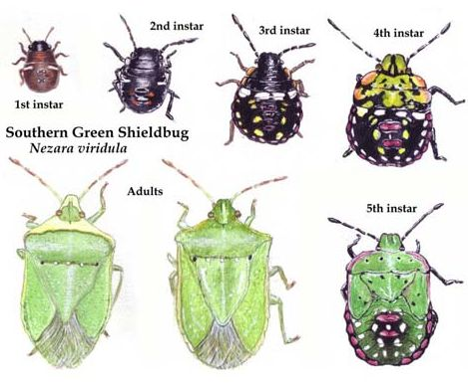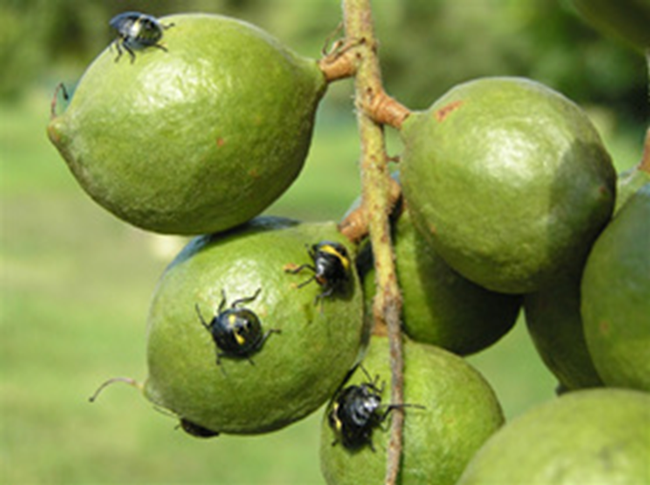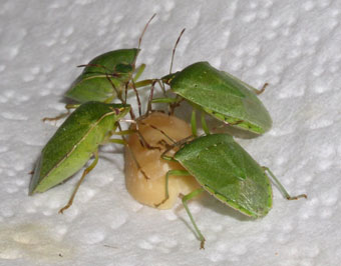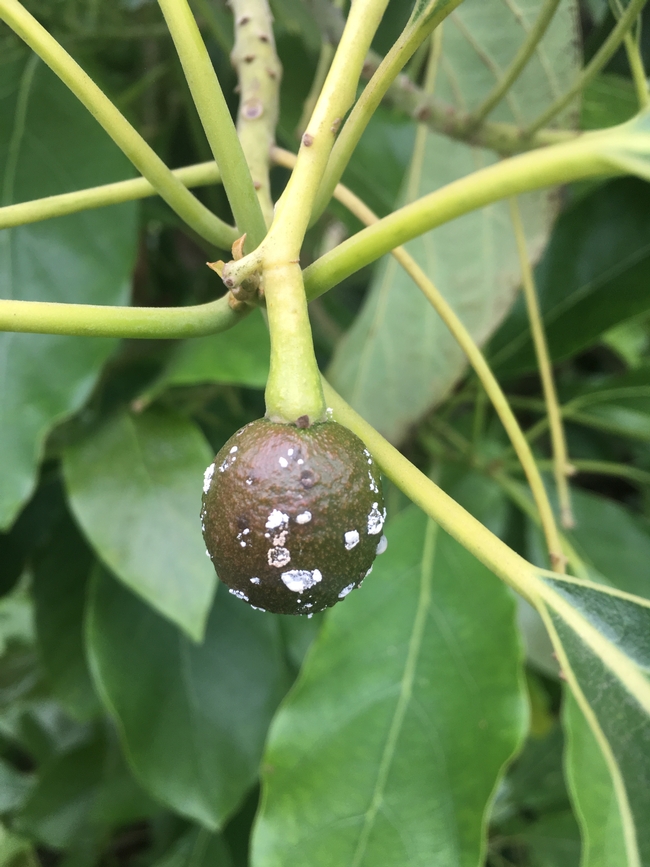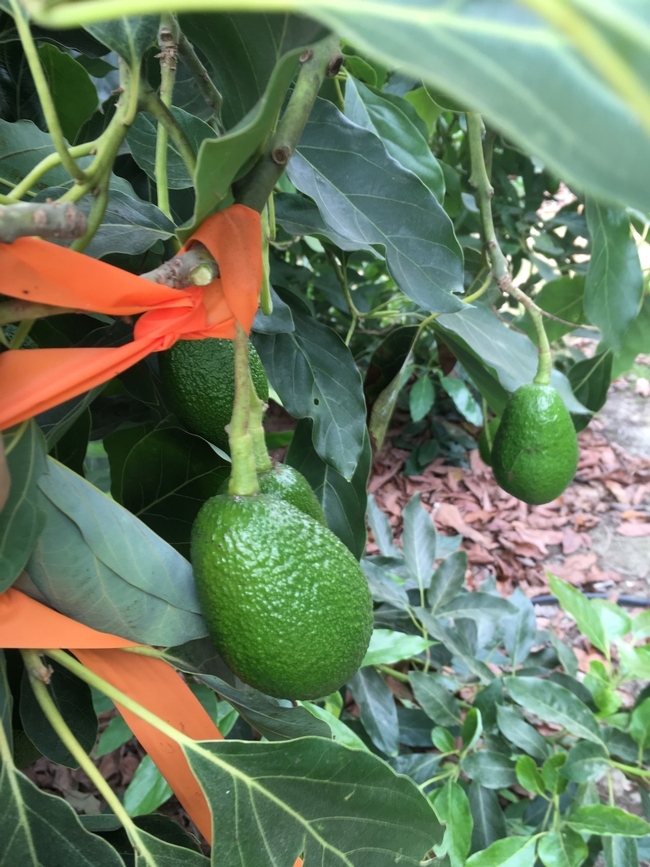
Posts Tagged: stink bug
STINK Bugs
Stink bugs of various species have been an issue on avocado and citrus for many years. Not always an issue, but occasionally they can reach damaging proportions.
//ucanr.edu/blogs/Topics/index.cfm?start=4&tagname=stink%20bug
For stink bugs to attract a mate or to communicate that they have found food, they use their own chemical language: pheromones.
Virginia Tech researchers have discovered insights into this chemical language, which can be used to develop alternative pest controls.
"We have gained a deeper understanding of how stink bugs synthesize pheromones, and this knowledge may allow us to produce pheromones in expendable food crops - also called 'trap crops' - to lure the bugs away from cash crops," said Dorothea Tholl, a professor of biological sciences in the College of Science and a Fralin Life Science Institute affiliate.
These new environmentally friendly and sustainable alternatives to insecticides could save farmers millions of dollars.
In Virginia, crops such as grapes, sweet corn, and apples, have been under attack by the invasive brown marmorated stink bug since 2004; cabbage has also been affected, but by the harlequin stink bug. A relative, the southern green stinkbug is also a severe pest worldwide and attacks many different crops including beans and soybeans.
Tholl is interested in the chemical communication of organisms and studies how this chemical language has evolved in insects. With support by a grant from the USDA National Institute of Food and Agriculture, her lab investigates the enzymes that produce stinkbug pheromones in an interdisciplinary collaboration with colleagues at Virginia Tech and national and international institutions.
Her team's research has recently been published in the journal Proceedings of the National Academy of Science, or PNAS.
"Our recent paper provides valuable insight into our understanding of how insects synthesize complex sesquiterpene compounds that are typically used as pheromones. The work could pave the way in the future for plants to manufacture insect pheromones, which could be utilized in pest surveillance and pest management strategies, such as attract and kill," said Thomas Kuhar, a professor of entomology in the College of Agriculture and Life Sciences and a Virginia Cooperative Extension specialist.
Very little was known about the biosynthetic evolution of these insect pheromones, and the research of Tholl's team has shown that stink bugs have their own enzymatic machinery to make pheromones without receiving them from symbiotic microbes or the host plant, as was previously thought.
Jason Lancaster of Knoxville, Tennessee, a recent biological sciences Ph.D. graduate from Tholl's lab, used next-generation sequencing to identify and functionally characterize the first enzyme in the biosynthetic pathway of the harlequin bug pheromone compound.
"Pheromones for thousands of insects are known, but very little is known about the synthesis of the pheromones. This paper focuses on terpene derived pheromones from the harlequin stink bug Murgantia histrionica and encompasses many years of research. Besides the development of dead-end trap crops, this research may allow establishing "RNAi interference" type gene silencing mechanisms to disrupt the pheromone production of the insect," said Lancaster.
Lancaster also found that other stink bugs such as the brown marmorated stink bug use enzymes in pheromone biosynthesis similar to that identified in the harlequin bug. Beyond the team's current study on stink bug pheromones, the research may allow for exciting future discoveries in the biosynthesis of pheromones of other insects and their application in pest management.
Two of Tholl's graduate students, Andrew Muchlinski and Bryan Lehner, are co-authors on the paper and contributed substantially to this research.
There is commercial interest in using the genetic tools developed by Tholl's team to produce the pheromones via synthetic biology for application in the field to promote pest mating disruption.
"Overall, we are excited about the prospect that our research has the potential to develop new pest management techniques," says Tholl.
https://www.eurekalert.org/pub_releases/2018-08/vt-dch081718.php
IMAGE: For stink bugs to attract a mate or to communicate that they have found food, they use their own chemical language: pheromones.

stink bugs mating

stink bug on avocado 1

avocado stink bug
Green Stink Bugs in Macadamias
The green stink bug is the dominant species found in fruit and nut trees; the others are found primarily in vegetables. Stink bug infestations originate when adults fly in from weedy areas. Damage is often limited to the edges of fields near these areas, but in years with a lot of spring rain and late weed growth, stink bugs may be numerous and damage more widespread. The southern green stink bug has piercing-sucking mouthparts. The mouth consists of a long beak-like structure called the rostrum. Salivary fluid is pumped down the salivary duct and liquefied food is pumped up the food canal.
Life Cycle
The southern green stink bug can complete its life cycle in 65 to 70 days. Females can lay eggs 3-4 weeks after becoming adults. A female southern green stink bug could lay as many as 260 eggs over her life span. The eggs are drum-shaped with circular "lids" are laid ire deposited on the undersides of leaves. The nymphs, nearly round & often brightly colored, remain close together at first but scatter as they grow. They pass through four or five molts, gradually developing wings & adult coloration.
Damage
Overwinters as an adult, & hides in the bark of trees, leaf litter, or other locations to obtain protection from the weather. As spring temperatures begin to warm, the southern green stink bug moves out of the winter cover to feed. Is normally determined after nuts are harvested & processed, which may be many months after damage occurred in the field. Damage occurs to the nut when the stink bug places its stylet-like mouthparts on the nut husk & secretes saliva containing a suite of digestive enzymes that softens the husk, allowing it to insert its mouthparts through the husk and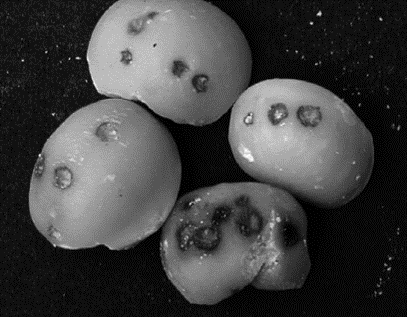
A major drawback in management is the lack of an effective monitoring technique (Jones 2002, Les-key & Hogmire 2005), an issue we address in many studies. Southern green stinkbug cannot survive on macadamia nuts alone and require a primary food plant, or host. Stinkbugs reproduce and develop on the weeds and feed on macadamia when their primary food plants become unavailable.
Growers who continually experience damage should monitor weed hosts surrounding the crop field. It may be possible to utilize trap-borders of preferred hosts such as Crotalaria (rattlepod) to attract and hold stink bug populations. Stink bugs will usually remain on the plants where parasites can readily find them. It is important that these borders not be allowed to dry before control occurs. California used Trissolcus basalis in an effort to control its southern green stink bug population.
Insecticidal applications are usually not required, however sprays may be needed if stink bug populations are high. This pest can be chemically controlled by the use of carbamates & organophosphate compounds. However, because most of these compounds persist on the treated plant for a relatively short period, the crop is vulnerable to re-infestation from nearby areas.
What Hit this Fruit?
Last May/June during a hot period and soon after fruit set, avocado growers and PCAs in the Oxnard/Camarillo area were calling in about young fruit about he size of a quarter showing up with white spots. Cutting into the fruit there might only be a small black spot just below the injury. Because that's what it is, a wound response on the part of the fruit to a physical damage. This occurred on several orchards also in the San Luis Obispo area and it seemed to happen in orchards that had recently been sprayed for avocado thrips. No piercing-sucking insects were found at any of these sites. Insects that would feed by feeding on the fruit and causing damage and malformed fruit. Insects that could typically make probing inspections of fruit prior to laying eggs. No eggs or larvae were found in the fruit. Nothing like lygus bug, BMSB, Bagrada bug or other stink bugs was found.
//ucanr.edu/blogs/blogcore/postdetail.cfm?postnum=15198
Did it have anything to do with the spray? With the hot weather? With the hot weather and the spray? With the hot weather and the insects that came with it? Did it have anything to do with the hot weather? Did it have anything to do with insects?
And then late June, the calls stopped. No more damaged fruit was being found. And then a lone call from Cayucos. Damage was found on young and older fruit. New damage seemed to be occurring on the fruit that normally sets later in that northern area. The grower walked the orchard and didn't find any bugs. The PCA swept the grove for insects. A yellow sticky card was put out.
So far, no insect has been found on the fruit. So what caused and "is" causing the damage to the fruit? It's not clear. Fruit that was damaged in Oxnard back in late May was tagged to see if it recovered. Ten fruit were flagged and two months later, those tagged fruit were still on the trees. So either the fruit that was attacked fell off with the initial damage or the fruit observed later had healed itself. Fruit have this capacity when they are actively growing to cover over damage. Often it is malformed. In most of cases with this fruit, the damage was very superficial. Occasionally, there deeper pits, but we didn't see any burrowing or tunneling.
If anyone else saw similar damage and has more to offer about this happening, I would be glad to hear about it.
Photos: Damaged fruit that was flagged and observed 2 months later.
Leaffooted Bugs are Here and Will Leave with Rain?
Our friend Jane Delahoyde has been finding new things on citrus. She first found leaffooted bug on lemons in late September and now has found it on mandarin. The finds are not geographically connected, so it appears to be that this stink bug relative is deciding the native vegetation is not so palatable and that it would rather feed on irrigated citrus.
Leaffooted bugs are medium to large sized insects that feed on fruits, fruiting vegetables, nuts, and ornamentals. They have piercing-sucking mouthparts that allow them to feed on plant parts, particularly seeds. Leaffooted bugs are in the family Coreidae and get their name from the small leaf-like enlargements found on the hind leg. They are closely related to other sucking insects, such as stink bugs (family Pentatomidae) that can also suck juices from plants.
Large aggregations of leaffooted bugs can also leave excrement on the surface of the fruit that can reduce its aesthetic appeal. Feeding on small fruit (e.g., lemons) can cause the fruit to abort, while feeding on medium-sized fruit can result in depressions or discoloration at the feeding site as the fruit expands and ripens. Feeding on mature fruit can cause slight discoloration to the surface of the fruit that should be of no concern to backyard gardeners, but pose problems for commercial growers.
More: http://www.ipm.ucdavis.edu/PMG/PESTNOTES/pn74168.html
Leaffooted Bug on Mandarin, right square in the middle of the fruit
X

leaffooted bug on orange
Another Result of the Drought
It is possible to blame a lot of things on the Drought, and here's another one. There have been reports of damaged fruit from the leaffooted bug - Leptoglossus occidentalis, although there are other species. This is a relative of stinkbugs which we have been seeing quite a number of this year. Bagrada Bug and the Brown Marmorated Stink Bug are also stink bugs.
The adults overwinter in wild areas on grasses and other hosts. Cool winters will often kill many of the adults, and in Southern California after a warm winter many survive. When the hills and surrounding areas dry up, they move to where they can find food – an orchard, a field, a backyard. They especially like fruit, which they pierce and suck, and older insects will inject an enzyme to digest the seed in the fruit. The piercing will cause a blemish to the fruit, but often it is still edible. Common fruits attacked are citrus, tomato and pomegranate. Nut crops can be heavily affected.
One of the problems with this pest is that the damage is seen long after the insect has departed, died, parasitized or predated. So, it is too late to spray. Mandarins, navels, figs and pomegranates could now be showing low level symptoms of the attack of these bugs.
Populations of these bugs fluctuate from year to year. Symptoms of damage often look like those of other stink bugs or even wind scarring. For more information see:
http://www.ipm.ucdavis.edu/PMG/PESTNOTES/pn74168.html
Image top to bottom:
Damage to citrus
Eggs
Adult

leaffooted bug damage on citrus

leaffooted bug eggs

leaffooted bug

